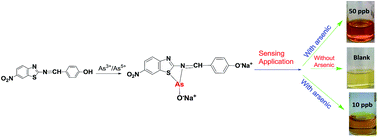Synthesis of new benzothiazole Schiff base as selective and sensitive colorimetric sensor for arsenic on-site detection at ppb level†
Abstract
The exposure of millions of people to unsafe levels of geogenic pollutant arsenic in drinking waters has sounded alarm bells for the development of low-cost methods for on-site continuous monitoring of arsenic in waters. Therefore, herein a new benzothiazole Schiff base colour probe is proposed to detect arsenic selectively in aqueous media. The arsenic probe was developed by simple condensation reaction via microwave method. The well-characterized sensing probe resulted in an instantaneous sharp colour change from light yellow to brown orange with an increase in arsenic concentration. With the colorimetric probe, the limit of detection for arsenic with naked eye speciation test is reported below the World Health Organization guideline of 10 μg L−1 within 10 s. The common coexisting ions in water samples were also scanned for colour response, confirming insignificant interference in arsenic detection. Therefore, this method is efficient for on-site detection of arsenic combined with a high tolerance to common coexisting ions.



 Please wait while we load your content...
Please wait while we load your content...